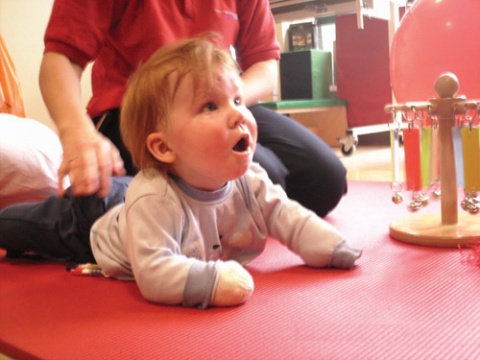Meningitis: what do you need to know?
An eight year old boy who lost his legs and hands to childhood meningitis should inspire us all with his incredible bravery. Remarkably, Marshall Janson has overcome his illness to take up Jiu-Jitsu. He has met some of the sport’s leading competitors and defied the expectations of his doctors by sparring in front of 10,000 spectators without even wearing his prosthetic legs¹ His family now fundraises for the cost of his treatment through HANDSTAND – The Appeal for Marshall Janson.

- Marshall starting physiotherapy for the first time.
Meningitis is a condition that most people have heard of, affecting around 3,200 people in the UK each year². However, there are some key facts that everyone should know about the illness, whether they are practitioners in Early Years or Public Health, or students attending university.
There are two forms of the infection. Meningitis is where the lining around the brain and spinal cord is inflamed. Septicaemia is a form of blood poisoning associated with the disease. This is far more likely to threaten the lives of its sufferers, particularly when they don’t show other symptoms of meningitis. It can be triggered by a wide range of different microbial pathogens, including bacteria, viruses and fungi. In the UK, though, most cases are bacterial³.
Marshall’s mother first noticed that something was wrong in the days following his first birthday. She saw a rash on his forehead and took him to hospital. Doctors fought to save his life and despite his vital organs failing twice, he escaped brain damage, blindness and deafness, which are common outcomes of the condition.
Symptoms to watch out for includes
- pain in limbs and muscles
- coldness in hands and feet
- rashes and stiff necks
- confusion
- aversion to light
There are many other symptoms that are similar to common conditions, though, so always consult a medical professional if you or someone else falls ill.
There are some factors that can increase the risk of contracting meningitis or septicaemia. Age, geographical location, pre-existing medical conditions and exposure to environmental dangers such as smoke are all important considerations⁴. Babies and young people up to five years old are the most at risk group, underlining the seriousness of Marshall’s infection.
However, teenagers are the second most at-risk group. This makes it a relevant issue for all students starting university. They are warned that they should ensure they are vaccinated when they start⁵. After all, university is a melting pot of unfamiliar people and they may carry the bug without knowing it.
Nonetheless, action is being taken to reduce the prevalence of meningitis and septicaemia. Children are routinely vaccinated and foreign travellers to high risk areas in Africa and Saudi Arabia are required to produce a certificate to prove that they have been vaccinated. Whilst not all strains can be prevented, there is progress in protecting the population, from vulnerable toddlers to university students and the elderly.
Read on the NHS website to find out more information or consult CU’s dedicated Student Support service.
²Meningitis Research Foundation
Material on this blog is provided for informational purposes only and is not a substitute for your own doctor’s medical care or advice.
